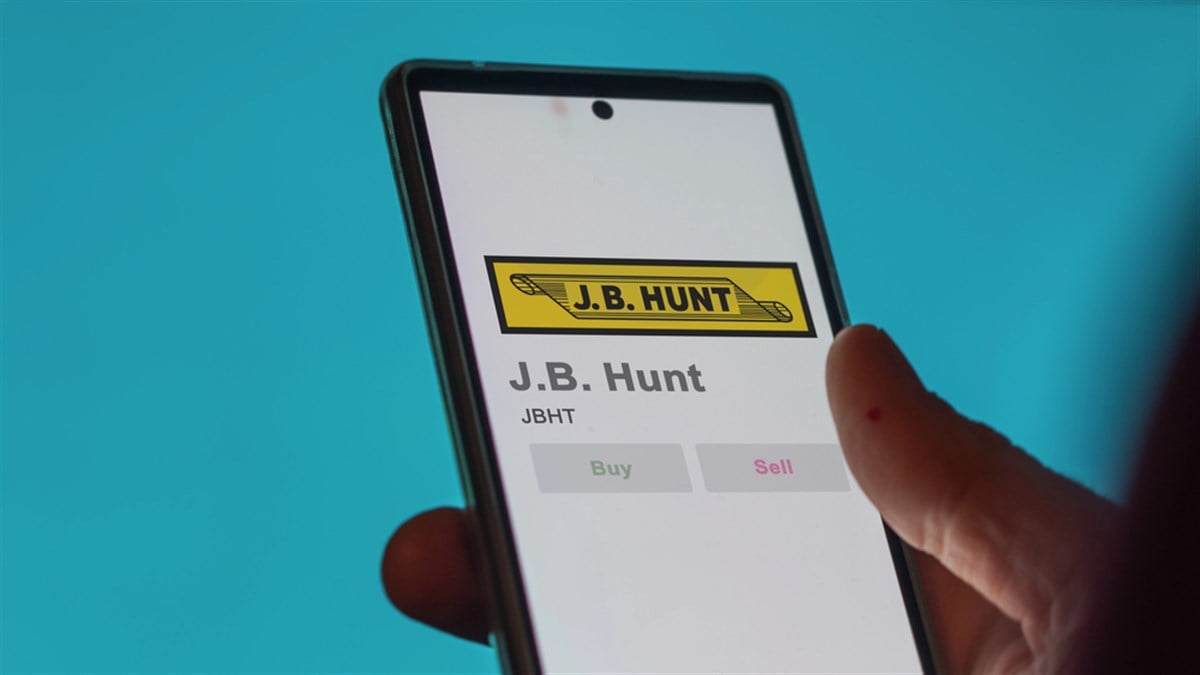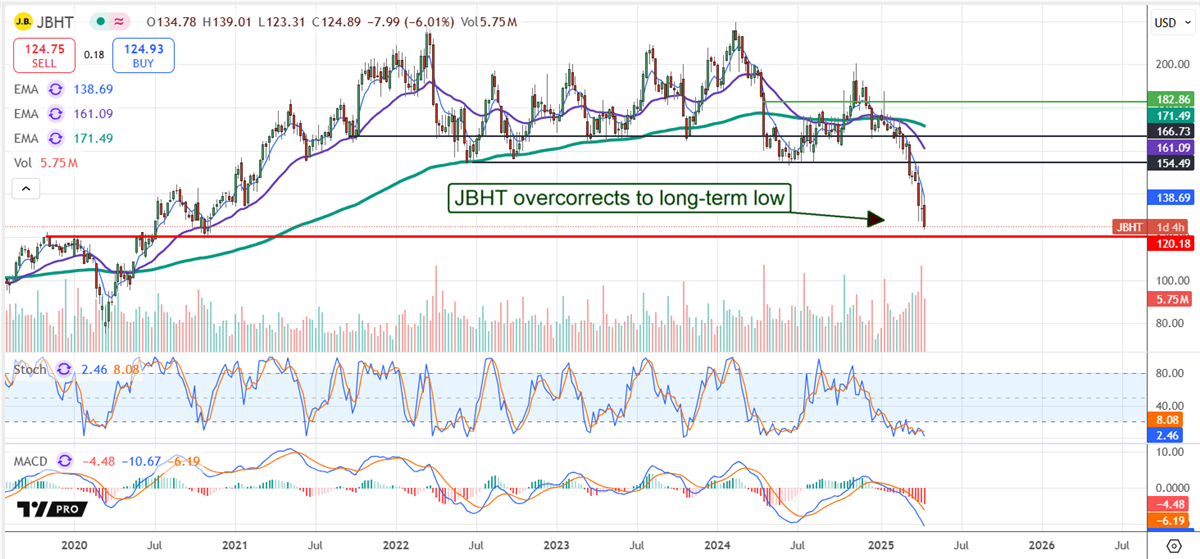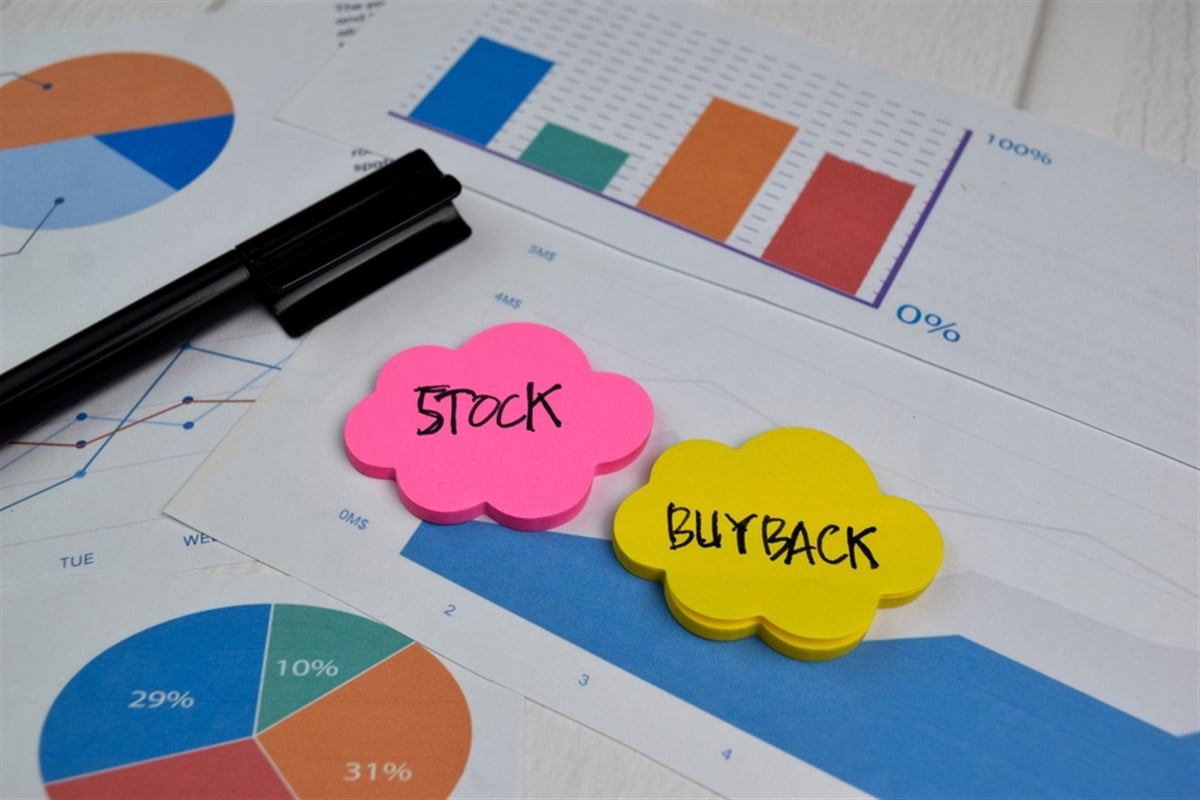 J.B. Hunt Transport Services is moving to a new low in April but setting up a solid rebound as it overextends and overcorrects.. ͏ ͏ ͏ ͏ ͏ ͏ ͏ ͏ ͏ ͏ ͏ |
| | Written by Thomas Hughes 
J.B. Hunt’s (NASDAQ: JBHT) stock share price came under pressure with the threat of tariffs and their economic impact and fell to a new low following its Q1 release. The low was catalyzed by tepid guidance relative to analysts' forecasts and the price target reset it caused. The takeaway is that JBHT analysts are impacting the price action in Q2. Still, the market has overcorrected, falling below the range's low end and offering investors a deep-value opportunity in this transportation stock.
This opportunity may not last long because the headwinds impacting sentiment in early Q2 could evaporate as quickly as they appeared.
MarketBeat tracked five analyst revisions within the first day of J.B. Hunt's Q1 release, four of which included lowered price targets. However, the consensus of the five consists of a solid Buy rating and a forecast for 25% upside.
The single outlier is a reiterated price target that adds $25 to the consensus of revisions and aligns with the broader consensus.
It forecasts a nearly 40% upside, but the lowest analyst price target highlights the value opportunity. Trading at $125, JBHT stock is more than 10% below the low target, trading at a critical support level that limits the downside risk. That level aligns with highs set in 2019 and the stimulus-induced breakout the following year.

J.B. Hunt: Business Contracts in Q1 But Less Than Expected
J.B. Hunt faced headwinds in Q1, including reduced truck counts, fewer stops, fewer total loads, and lower revenue per mile in critical segments. However, the damage was less than feared, leaving the quarterly revenue at $2.92 billion, down 0.7% annually but 70 basis points better than expected.
Segmentally, Intermodal was strongest, with a 5% gain driven by volume increases, but weaknesses in all other segments offset the strength. Dedicated Contract Services fell by 4%, Integrated Capacity Solutions by 6%, Trucking by 7%, and Final Mile Services by 12%.
The margin news is another area with hidden strength. The company experienced margin pressure, but less than expected, leaving the GAAP and adjusted earnings down year-over-year but ahead of forecasts. The critical detail is that earnings are sufficient to sustain the company’s financial health during the business downturn, including the dividend and share repurchases.
Share repurchases were robust in F2024 and Q1 F2025, reducing the count by about 4% by the end of the reporting period. Regarding the dividend, the stock yields about 1.4%, with shares at a multi-year low, the highest forward yield it has offered in many years.
The balance sheet reflects the business slowdown and aggressive buybacks with decreased cash and increased debt, but no red flags exist. The company’s positive cash flow can sustain the business, and debt leverage is low at roughly 0.25x equity.
Institutional Activity is Bullish for J.B. Hunt
Institutional activity, including selling, ramped to a multi-year high in Q1 2025 but is otherwise bullish for this market.
The balance of activity is buying, increasing ownership to roughly 75% of the stock, and providing a solid support base for the market. Institutional buying will likely increase in pace now that shares are at a long-term low.
The risk is that the tariff threat results in a more significant business contraction, leading analysts to continue lowering their price targets and institutions to reduce their exposure.
J.B. Hunt's stock price can continue to fall. However, the market has become extended and is nearing a critical support target where a rebound is likely.
The critical support target is near $120 and will likely be reached in April.  Read This Story Online Read This Story Online | Trump is making bold moves before even stepping back into the White House — securing border deals, brokering peace talks, and targeting sanctuary city funding. But according to 33-year Wall Street veteran Dylan Jovine, even Trump may not be able to fix what’s coming.
Jovine believes there are five cracks forming in the U.S. economy — big enough to spark a 50% market crash, a 40% real estate plunge, and a surge in unemployment. That’s why he’s moved seven figures of his own money into a “safe haven” asset favored by names like Buffett, Musk, and Ackman.
He’s released an emergency briefing explaining why the next 90 days could be critical for investors. Wall Street vet warns of 5 economic cracks Trump can’t fix — here’s where billionaires are moving th |
| Written by Jeffrey Neal Johnson 
AppLovin Corporation (NASDAQ: APP), a mobile marketing platform, has presented a contrasting image for tech sector investors. The company’s share price soared past $500 after the announcement of outstanding full-year 2024 financial results in February 2025. However, this peak was short-lived, with AppLovin’s stock price dropping since then to around $245, despite the company reporting triple-digit percentage growth in net income and above-average expansion in its core advertising business.
The stock's high trading volume, often among the most active by dollar volume, highlights intense market interest in the company. Still, investors seem to be grappling with the contradiction of excellent reported fundamentals versus substantial market headwinds, including valuation concerns, short-seller scrutiny, and shifting analyst community sentiment.
AppLovin's Profit Surge
AppLovin's financial performance in fiscal year 2024, particularly its advertising technology segment, initially strengthened its bullish outlook. The company's February 12, 2025, earnings release showed a 43% surge in total revenue to $4.71 billion, with the advertising segment (formerly "Software Platform") driving the growth with a 75% revenue increase to $3.22 billion.
The Apps segment saw a more modest 3% revenue growth to $1.49 billion, reflecting the company's strategic focus on its higher-margin advertising platform.
Management expressed confidence in continued momentum, providing strong guidance for the first quarter of 2025. It projects total revenue between $1.355 billion and $1.385 billion and adjusted EBITDA between $855 million and $885 million, implying a sustained high margin between 63% and 64%. This strong performance is largely attributed to the increasing effectiveness and adoption of AppLovin's AXON AI-powered advertising engine.
Why is AppLovin Stock Under Pressure?
Despite the powerful financial results and optimistic guidance issued in February, AppLovin's stock narrative took a sharp turn. The significant pullback from its post-earnings highs suggests the market is weighing several potent headwinds against the reported fundamentals. Valuation remains a central point of discussion. Even after the decline, AppLovin trades at demanding multiples.
As of mid-April 2025, its trailing twelve-month price-to-earnings ratio (P/E) stood near 54, with a price-to-sales ratio (P/S) exceeding 17. While the forward P/E is lower at approximately 36, anticipating strong earnings growth, these levels indicate that substantial future success is already embedded in the share price, leaving little room for operational missteps or macroeconomic pressures. The stock's high beta of 2.39 further confirms its heightened sensitivity to market swings.
Recent scrutiny from short sellers has added to the pressure. On March 28, 2025, AppLovin announced it had retained the prominent law firm Quinn Emanuel Urquhart & Sullivan, specifically partner Alex Spiro, to conduct an independent investigation into "recent short report activity." While the company did not detail the specific contents of the short report, the move itself signals a defensive posture against market allegations.
This development coincided with a flurry of announcements from various plaintiff law firms soliciting investors for class-action lawsuits alleging potential securities fraud. The firms frequently cited a lead plaintiff deadline of May 5, 2025. Such legal challenges introduce uncertainty and potential financial risk.
While still leaning positive overall with a moderate buy consensus rating, analyst sentiment has shown recent signs of increased caution. The average analyst price target of approximately $424 suggests a potential upside from current levels. However, a crucial counter-trend emerged in April 2025, with multiple influential firms issuing noteworthy reductions to their respective price targets for AppLovin.
While most firms maintained their existing ratings—such as Neutral or Buy/Overweight—the downward revisions to price targets suggest a more cautious outlook or an increased perception of risk. Furthermore, data reveals substantial selling by company insiders over the past twelve months, totaling approximately $1.93 billion across 11 executives and directors, separate from large divestitures by early investors. While insider selling can occur for various reasons, it must be noted that the volume being sold has been significant.
AppLovin Board Moves
AppLovin recently appointed Maynard Webb, founder of Webb Investment Network, to its Board of Directors. Webb brings extensive experience, with current board roles at Visa and Salesforce and past leadership positions at Yahoo and eBay. He will also serve on the Audit, Nominating, and Corporate Governance Committees. This move is meant to strengthen AppLovin's corporate governance during a time of rapid growth and market scrutiny.
At the same time, Ted Oberwager, representing early investor KKR, will not stand for re-election at the 2025 Annual Meeting. This is typical as private equity sponsors seek to reduce involvement in the company post-IPO.
What's Next for AppLovin Stock?
AppLovin stands squarely at a crossroads. On one path lies its impressive track record of execution, which has resulted in substantial revenue growth and profitability expansion. On the other path loom significant market headwinds: demanding valuation multiples, the fallout from short-seller allegations culminating in an internal investigation and external lawsuits, recent cautionary signals from analysts via lowered price targets, and notable insider share sales.
While the company's technological prowess and market position offer long-term potential, the recent pressures create considerable near-term uncertainty for shareholders.
The next major checkpoint will be the release of the company's first-quarter 2025 financial results, tentatively expected around May 7, 2025. Investors will be focused on whether the company can sustain its high growth trajectory, maintain its margins, and provide commentary that addresses the concerns currently weighing on its share price.  Read This Story Online Read This Story Online | Trump is making bold moves before even stepping back into the White House — securing border deals, brokering peace talks, and targeting sanctuary city funding. But according to 33-year Wall Street veteran Dylan Jovine, even Trump may not be able to fix what’s coming.
Jovine believes there are five cracks forming in the U.S. economy — big enough to spark a 50% market crash, a 40% real estate plunge, and a surge in unemployment. That’s why he’s moved seven figures of his own money into a “safe haven” asset favored by names like Buffett, Musk, and Ackman.
He’s released an emergency briefing explaining why the next 90 days could be critical for investors. Wall Street vet warns of 5 economic cracks Trump can’t fix — here’s where billionaires are moving th |
| Written by Leo Miller 
Several stocks just announced share buyback authorizations, indicating their intentions to return substantial capital to shareholders. These names range in size from mid-cap to large-cap to one of the largest publicly traded companies in the world. Below are the details on these three names.
All metrics use data as of the Apr. 16 close unless otherwise indicated.
SEIC: Buyback Spending Has Potential to Hit Another Yearly Record
First up is SEI Investments (NASDAQ: SEIC). On Mar. 18, the financial services company announced an increase to its previous share buyback authorization of $500 million. Overall, the company now has $556 million in buyback capacity. The company's market cap is about $9 billion. This buyback ability is significant, making up roughly 6.1% of its total value.
In 2024, SEI spent a record $500 million on buybacks. Using the full $556 million in buyback capacity in 2025 would break the firm's record for buyback spending for the second year in a row. The company’s use of dividends adds to its strategy to return capital. The stock has a solid indicated dividend yield of approximately 1.4%.
AVGO: Chip King Looks to Spend Billions on Buybacks and Fast
Next up is the world’s second-largest stock in the semiconductor industry, Broadcom (NASDAQ: AVGO). On Apr. 7, this chip stock announced a new share repurchase program that allows it to buy back up to $10 billion of its common stock. This represents approximately 1.2% of the firm’s total market capitalization. Although this is a fairly small buyback announcement compared to the size of the firm, the speed at which Broadcom may use it provides added value.
This buyback authorization ends on Dec. 31, 2025. This means that Broadcom likely intends to utilize the full capacity in just eight months. This expected pace contrasts significantly with many buyback authorizations, which can last indefinitely. In these cases, companies may authorize a larger buyback program relative to their size, but take several years to utilize it.
All else being equal, a faster buyback pace is more beneficial to shareholders. It means capital is being returned sooner, and investors can reinvest the proceeds to generate returns rather than having to wait.
Broadcom may have seen an opportunity to buy back its shares at a discount, as its stock has dropped by around 24% in 2025. Post-2021, Broadcom has ramped up its use of share buybacks considerably. Over the past three fiscal years, Broadcom has spent an average of around $6.7 billion per year through its share repurchase programs. This figure does not include shares repurchased for tax withholdings on the vesting of equity awards.
If Broadcom uses the full $10 billion, it would significantly accelerate its buyback pace compared to recent years. The fall in Broadcom's stock price adds weight to the idea that the management team sees an opportunity. Broadcom also announced a substantial 11% increase to its dividend in December 2024. The stock has an indicated dividend yield of around 1.3%, on par with that of the S&P 500 Index.
XPO: Big Time Buyback Authorization, but Spending Pace Could Go Either Way
Last is XPO (NYSE: XPO). This ground transportation stock announced a share repurchase authorization worth $750 million on Mar. 27. This replaces, rather than adds to, the company’s previous share repurchase program. With a market cap of around $11 billion, this buyback program equates to a very significant portion of the firm’s overall value at around 6.8%.
However, over the last several years, XPO has slowly bought back shares. From 2020 to 2024, it spent an average of just $69 million a year on buybacks. The company ended its last buyback program with a capacity of $503 million left. This shows it was not in a hurry to use its buyback authorization. This suggests that the company may continue to do the same with this new program despite increasing its capacity.
However, the firm has spent huge amounts on repurchases in the past. It spent a whopping $1.4 billion in 2019 and nearly $600 million in 2018. The new buyback authorization indicates that it could be gearing up to do so again. It may not have seen its $503 million capacity as enough compared to the repurchases it wants to make in 2025.
Together, these three stocks raised their buyback capacity by more than $12 billion, reflecting their commitment to returning capital to shareholders.  Read This Story Online Read This Story Online | Trump is making bold moves before even stepping back into the White House — securing border deals, brokering peace talks, and targeting sanctuary city funding. But according to 33-year Wall Street veteran Dylan Jovine, even Trump may not be able to fix what’s coming.
Jovine believes there are five cracks forming in the U.S. economy — big enough to spark a 50% market crash, a 40% real estate plunge, and a surge in unemployment. That’s why he’s moved seven figures of his own money into a “safe haven” asset favored by names like Buffett, Musk, and Ackman.
He’s released an emergency briefing explaining why the next 90 days could be critical for investors. Wall Street vet warns of 5 economic cracks Trump can’t fix — here’s where billionaires are moving th |
|
| |
|
|
